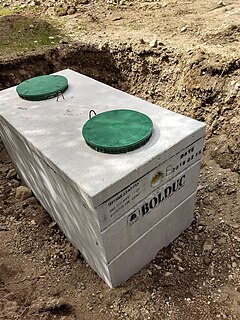
A septic tank is an underground chamber made of concrete, fiberglass, or plastic through which domestic wastewater (sewage) flows for basic treatment. Settling and anaerobic processes reduce solids and organics, but the treatment efficiency is only moderate. Septic tank systems are a type of simple onsite sewage facility (OSSF). They can be used in areas that are not connected to a sewerage system, such as rural areas. The treated liquid effluent is commonly disposed in a septic drain field, which provides further treatment. Nonetheless, groundwater pollution may occur and can be a problem.

Wastewater treatment is a process used to remove contaminants from wastewater or sewage and convert it into an effluent that can be returned to the water cycle with acceptable impact on the environment, or reused for various purposes. The treatment process takes place in a wastewater treatment plant (WWTP), also referred to as a Water Resource Recovery Facility (WRRF) or a Sewage Treatment Plant (STP) in the case of domestic wastewater. Pollutants in wastewater are removed, converted or broken down during the treatment process.

The Rhode Island State House is the capitol of the state of Rhode Island, located on the border of the Downtown and Smith Hill sections of Providence. It is a neoclassical building which houses the Rhode Island General Assembly and the offices of the governor, lieutenant governor, secretary of state, and general treasurer of Rhode Island. The building is policed by the Rhode Island Capitol Police and is on the National Register of Historic Places.

The Milwaukee Metropolitan Sewerage District (MMSD) is a regional government agency that provides water reclamation and flood management services for about 1.1 million people in 28 communities in the Greater Milwaukee Area. A recipient of the U.S. Water Prize and many other awards, the District has a record of 98.5%, since 1994, for capturing and cleaning wastewater from 28 communities in a 411-square-mile (1,060 km2) area. The national goal is 85% of all the rain and wastewater that enters their sewer systems.
Milorganite is a brand of biosolids fertilizer produced by treating sewage sludge by the Milwaukee Metropolitan Sewerage District. The term is a portmanteau of the term Milwaukee Organic Nitrogen. The sewer system of the District collects municipal wastewater from the Milwaukee metropolitan area. After settling, wastewater is treated with microbes to break down organic matter at the Jones Island sewage treatment plant in Milwaukee, Wisconsin. The byproduct sewage sludge is produced. This is heat-dried with hot air in the range of 900–1,200 °F (482–649 °C), which heats the sewage sludge to at least 176 °F (80 °C) to kill pathogens. The material is then pelletized and marketed throughout the United States under the name Milorganite. The result is recycling of the nitrogen and phosphorus from the waste-stream as fertilizer. The treated wastewater is discharged to Lake Michigan.

The Slater Mill is a historic textile mill complex on the banks of the Blackstone River in Pawtucket, Rhode Island, modeled after cotton spinning mills first established in England. It is the first water-powered cotton spinning mill in North America to utilize the Arkwright system of cotton spinning as developed by Richard Arkwright.

Sewage sludge treatment describes the processes used to manage and dispose of sewage sludge produced during sewage treatment. Sludge is mostly water with lesser amounts of solid material removed from liquid sewage. Primary sludge includes settleable solids removed during primary treatment in primary clarifiers. Secondary sludge separated in secondary clarifiers includes treated sewage sludge from secondary treatment bioreactors.
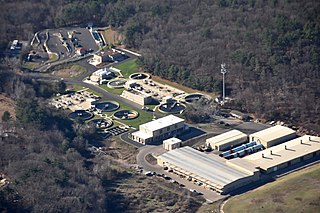
Sewage treatment is the process of removing contaminants from municipal wastewater, containing mainly household sewage plus some industrial wastewater. Physical, chemical, and biological processes are used to remove contaminants and produce treated wastewater that is safe enough for release into the environment. A by-product of sewage treatment is a semi-solid waste or slurry, called sewage sludge. The sludge has to undergo further treatment before being suitable for disposal or application to land.

The College Hill Historic District is located in the College Hill neighborhood of Providence, Rhode Island, United States. It was designated a National Historic Landmark District on December 30, 1970. The College Hill local historic district, established in 1960, partially overlaps the national landmark district. Properties within the local historic district are regulated by the city's historic district zoning ordinance, and cannot be altered without approval from the Providence Historic District Commission.
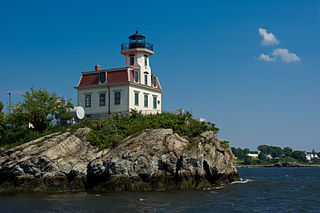
Pomham Rocks Light is a historic lighthouse in the Providence River about 200 yards (180 m) off the shoreline of the Riverside neighborhood of the city of East Providence, Rhode Island.

The Woods–Gerry House is an historic house on 62 Prospect Street in Providence, Rhode Island. It is a large, three story brick structure, designed by Richard Upjohn and built in 1860 for Dr. and Mrs. Marshall Wood. It is the largest surviving 19th-century house in Providence, measuring 55 feet (17 m) in width and 75 feet (23 m) in depth. It features restrained Italianate styling, most evident in its porch and porte-cochere, and in its roofline. The building currently houses the Admissions office for the Rhode Island School of Design.
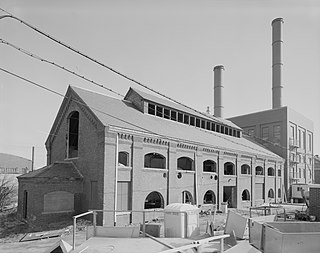
The Chemical Building is a historic wastewater treatment building at Field's Point Wastewater Treatment Facility in Providence, Rhode Island. Built in 1900–01, it is one of the two oldest buildings at Providence's main sewage treatment facility. It is a 2-1/2 story brick structure measuring 103 feet (31 m) by 38 feet (12 m). The long facades are divided into 9 bays, separated by brick piers. When originally built, the structure had a concrete first floor, a wooden second floor, and a loft area accessed by catwalks, and was used to hold and deliver chemicals used to neutralize the wastewater arriving via the Ernest Street Sewage Pumping Station. In the 1930s the plant was converted to use an active sludge process, and the interior of the building was altered to be a single large chamber.

The Ernest Street Sewage Pumping Station is an historic wastewater pumping station at Ernest and Ellis Streets near the wastewater treatment facility at Field's Point in Providence, Rhode Island. The surviving elements of the station include a main pumphouse and a smaller screening house, both built in 1897-98 as part of a major effort to modernize Providence's sewage treatment facilities. A third structure, a boiler house, was demolished in 1987, and a tall smokestack was taken down in the 1930s. The main pumphouse is a tall single-story brick structure with a hip roof and Colonial Revival features, and is set near Ernest Street, a short way east of its junction with Allens Avenue. The screening house is a smaller square structure, also with a hip roof, set behind and to the right of the pumphouse. The facility is used to pump raw sewage through an 88-inch main to the treatment facility.

The Joseph Haile House is an historic house in the College Hill neighborhood of Providence, Rhode Island. It is a 3 1⁄2-story brick structure, appearing taller than that due to its hillside location and raised basement. It is a well-preserved example of Federal styling, which underwent a careful restoration in the 1930s by George Warren Gardner, who filled the house with early American furniture. The Gardners bequested the property to Brown University, which uses it to house visiting dignitaries.

The Thomas F. Hoppin House is a historic house at 383 Benefit Street in the College Hill neighborhood of Providence, Rhode Island. The house was built c. 1853 to a design by Alpheus C. Morse, and is an elaborate local example of an Italianate palazzo-style residence. The Hoppins were well known for the social gatherings, and their house became known as the "house of a thousand candles". The Library of Congress called the property "one of the largest and most elegant houses built in Providence in the mid-nineteenth century." At one time, the front lawn was home to "The Sentinel," a bronze statue of a dog, which was designed by Hoppin and cast by the Gorham Company; the statue was later moved to Roger Williams Park.

The Reservoir Avenue Sewage Pumping Station is an historic wastewater pumping facility on the south side of the junction of Reservoir and Pontiac Avenues in southern Providence, Rhode Island. From the street it looks like a single-story brick structure with a hip roof, and metal doorways on its north and east elevations. This building stands atop a substantial concrete substructure, which houses a dry well and wet well. The dry well, on the eastern side, houses the pumps, while the wet well, occupies the western two-thirds of the facility. The floor of the interior includes glass blocks for viewing the facilities below, as well as metal trapdoors for accessing the pumps. Manual gate valves on the west side are used to control sewage flow through the west well. This facility is used to pump raw sewage eastward and uphill to a gravity conduit in Rutherglen Avenue. This conduit carries the sewage to the Field's Point treatment facility. The pumping station was built by the city of Providence in 1931, and is now owned by the Narragansett Bay Commission, which operates the region's wastewater treatment facilities.
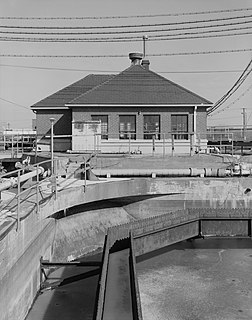
The Return Sludge Pumping Station, Fields Point Sewage Treatment Plant is an historic wastewater pumping station in the Field's Point Sewage Treatment Facility on Ernest Street in Providence, Rhode Island. It is a rectangular hip-roofed brick and concrete structure, located adjacent to the facility's aeration tanks, and is not readily visible from any public way. The building houses a number of large pumps in a large concrete substructure that is below grade. The facility was built in 1934–35, when the sewage treatment method was changed from a chemical process to a biological one, and is used to return biologically active sludge from the aeration tanks back into the treatment process. The pumps in the building are no longer original, having been replaced several times. The building is one of three to survive in the Field's Point area from the early decades of Providence's wastewater treatment system. the others are the Ernest Street Sewage Pumping Station and the Chemical Building; the Sludge Press House was demolished sometime in the last 30 years.

The Washington Park Sewage Pumping Station is an historic wastewater pumping facility on Shipyard Street in Providence, Rhode Island. Its principal visible component is a concrete block structure, finished in stucco and topped by a hip roof, which is about 16 by 16 feet. This building stands atop a large cast-in-place concrete well, in which pumps and gate valves are housed. The facility was built in 1911 to pump raw sewage from the low-lying Washington Park area to the Field's Point wastewater treatment facility, which lies about 1,000 feet (300 m) to the north. The pump station is located well back from the street, behind a low brick distribution facility. It was added to the National Register of Historic Places in 1989.

Fields Point is a historic park in the Washington Park neighborhood of Providence, Rhode Island jutting into Narragansett Bay right near the Providence River and Route 95.

The Office of City Engineer of Providence, Rhode Island is an office that is credited with the design of a number of notable public works.




















